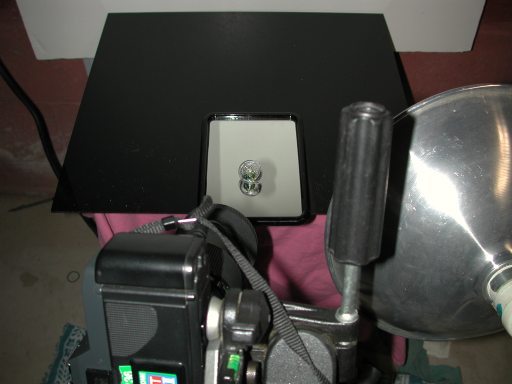
Granted, this picture is for a single bead, but it shows the camera mounted on the tripod, with the black plexi, the light (make certain the base is ceramic). Use tungsten fujichrome type II 64T film, and matching 500w photofloods (I can never remember whether that's 3200 or 3400 kelvins, but the photography shop will be able to tell you.) Turn the light off when you're not actually shooting! The bulbs will a) overheat your lamp, even one with a ceramic base, and b) they begin to lose their color correctness after a few hours.
For jewelry, the camera won't be as close. Position the light beside and as close to the camera as possible (it quite often gets in the way of my seeing through viewfinder), and about the same or slightly higher as the camera. Try with the light positioned at 90deg (horizontally, so it makes a spot on your white background) and then tilt it as necessary to light the piece (with the bounce light, of course). To remove the hot spots (specular highlights) use some diffusing material, such as frosted fluorescent light panels. Be sure to buy color neutral white. The panel, which diffuses light falling directly upon the piece, can be tilted until you get the dark to light graduation I attempt in my pictures.
Take my word for it, the pictures will look awful without the diffuser, even though your eyes will adjust. With the diffuser, a 500w bulb and an f-stop of 22, I shoot in the range of 1/2 sec or so, though I recall shots as little as 1/15 or even 1/30 and some as long 4 sec. But most seem to be in the 1/4 to 2” range. That is with a canon t-70 and a vivitar macro telephoto lense. Your mileage may vary, depending on how efficient your (father's) lense is. I always lay an 18% grey card on top of the jewelry to get my initial reading, and totally ignore what my camera's light meter says with actual jewelry on the black background. I recommend bracketing in half f-stop increments at least one full stop out from the light meter (e.g. 5 shots per setup)
Good luck!
Unless otherwise noted, text, image and objects depicted therein copyright 1996--present sylvus tarn.
Sylvus Tarn